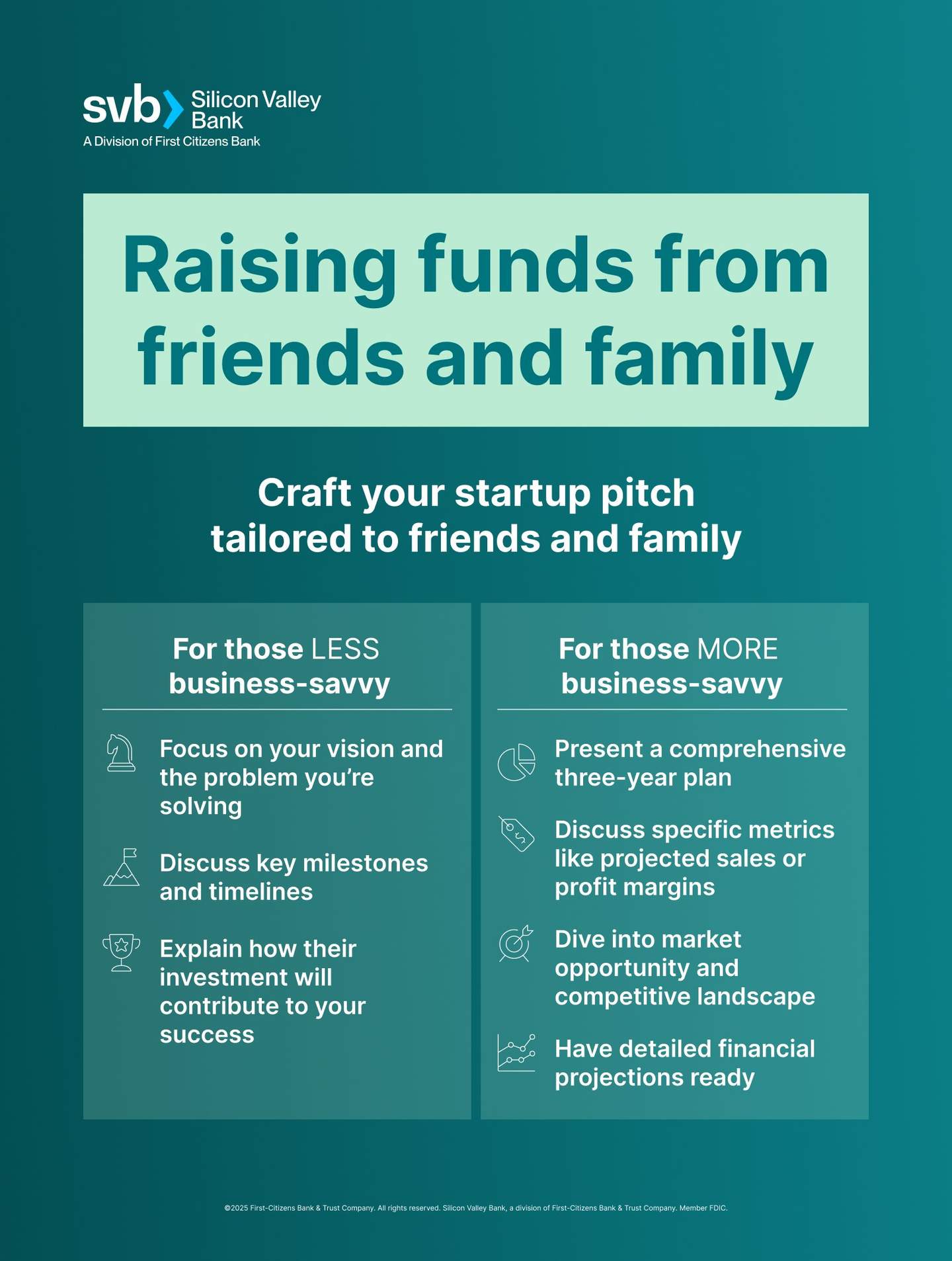- Be transparent about the risks of investing, emphasizing the potential of zero returns. Honesty builds trust and protects relationships.
- Maintain communication and set clear expectations for updates and delivery transparently. This keeps everyone informed and engaged.
- While friends and family funding can be a great starting point, aim to transition to professional investors. This instils discipline and positions your business for long-term growth.
The complexities of raising money from friends and family
Launching a startup is exciting, and it’s natural for friends and family to support you. However, accepting investments from loved ones requires careful consideration. As Joshua Greenough began opening up about his idea for a startup, a coupons app called Bankons, friends and family got excited. Some, including his mother-in-law, offered to invest.
Grateful as he was for her support, the offer gave him pause. “As a founder, you have a moral obligation,” Greenough says. “What happens if the business fails? Does the person really understand the risk involved?” After pondering those questions, he got back to his mother-in-law – “I said no.”
Greenough, however, said yes to others in his inner circle, including his father, a CFO with more than 20 years of experience. His father clearly understood the investment risk. What’s more, he stood to benefit, albeit intangibly, even if Greenough’s startup failed. “His bet on accelerating my own career was his own downside protection,” Greenough says.
Not every entrepreneur has a veteran CFO at the ready, but Greenough’s experience offers powerful lessons for anyone seeking to raise startup funds from friends and family.
What is a friends and family round?
A friends and family round is often the first round of funding for many startups, where founders raise capital from their personal network. This typically involves smaller investments compared to later funding rounds. This round can be crucial for validating your business idea, developing a minimum viable product (MVP) and gaining traction before seeking professional investors.
According to recent data reported by USA Today, 38% of startups rely on friends and family for funding. This data underscores the significant role that personal networks can play for fundraising in the startup ecosystem.
Crafting your pitch for friends and family
There are some ways to craft a pitch tailored to friends and family. A close relative might appreciate hearing about your idea face-to-face, whereas a former colleague that you’ve kept in touch with over the years might accept an email with an offer to discuss your idea in person.
Danny Harris, a founder who launched mobile app GMDY, emailed about 40 people. Most were close friends; some were family and colleagues. And all had some familiarity with his idea for a sportswear shopping app. “There was no secret with the group that I was reaching out to,” Harris says. While Harris was able to raise the money he needed, he says he could have benefited from more personal outreach. “It’s easy to ignore emails,” he says.
While entrepreneurs' passion and optimism are essential drivers of innovation, successfully raising funds from friends and family requires a balanced approach. Beyond clearly communicating the risks, it's crucial to consider how to present your idea effectively and structure the investment. It’s also important to “know your audience” as you present your startup idea to your friends and family. For example, take into consideration their level of understanding of business principles and strategies. The goal is to inspire confidence without overwhelming them with unnecessary complexity.
For those less familiar with entrepreneurial business:
- Focus on your vision and the problem you're solving.
- Discuss key milestones and timelines.
- Explain how their investment will contribute to your success.
For more business-savvy individuals:
- Present a comprehensive three-year plan.
- Discuss specific metrics like projected sales or profit margins.
- Be prepared to dive into market opportunity and competitive landscape.
- Have detailed financial projections ready.

If your friends and family audience is business-savvy, present your idea as you would with any other investor. “I would layout the goal for the year as well as three years ahead,” says Sarp Sekeroglu, CEO and co-founder of Water Pigeon. “Here, you might want to discuss specific metrics, like the number of units you expect to sell or the profit margin you’re targeting, just as if you were pitching a professional investor,” he says. And like with any pitch, do not overpromise, he adds.
Be clear about the funding risk
Savvy entrepreneurs recognize that friends and family investments are more than just convenient capital—they're strategic stepping stones. To protect both your venture and your personal connections, it's crucial to approach these arrangements with professionalism, clarity and candor. Be transparent about the potential downsides, including the possibility of financial loss. By structuring these investments thoughtfully and communicating openly about risks, you not only safeguard relationships but also establish a solid foundation for your company's financial future.
Regardless of your audience, always:
- Be transparent about risks.
- Have detailed information ready if requested.
- Avoid overpromising.

“The one thing I stress the most is that the downside is zero dollars,” says Sekeroglu, echoing Greenough and many other founders. “If you’re relying on this money for anything important, do not make this investment in me or anybody else.”
Indeed, the risk of failure in startups is significant. According to the latest data from the US Bureau of Labor Statistics, approximately 20% of new businesses fail within their first year, and about half don't survive beyond five years. These statistics underscore the importance of careful planning and realistic expectations when launching a startup.
Once you've captured their interest with a compelling pitch and clearly explained the risks, the next step is determining how much equity to offer in exchange for their investment.
Understanding equity distribution and dilution in early funding rounds
One of the most critical decisions founders face when raising capital is determining how much equity to offer investors. This decision becomes even more nuanced when dealing with friends and family rounds and subsequent seed rounds. Let's explore the key considerations for equity distribution in these early funding stages.
How much equity to give away in friends and family round?
Determining how much equity to give away in a friends and family round is a critical decision. While there’s no one-size-fits-all answer, it typically ranges from 5% to 20%. Consider factors like the amount of money being raised, the stage of your startup and the level of involvement of your investors. It’s important to consult with a legal professional to structure the deal appropriately and avoid future complications. Cooley Go, for example, offers excellent resources on understanding the difference between friends and family, seed and Series A financing.
Beware of securities laws that may apply to your fundraising efforts. Even when raising money from friends and family, you may need to comply with SEC regulations. Consult with a securities lawyer to ensure you’re following all applicable laws and regulations.
How much equity to give away in a seed round?
A seed round typically follows a friends and family round and involves raising capital from angel investors or venture capitalists. The equity (shares of your startup) you give away in a seed round is usually higher than in a friends and family round, often between 10% and 20%. This will depend on the valuation of your company, the amount of funding raised and the investor’s expectations. At this stage of fundraising, it's important not to give away too much equity because you'll need to leverage equity for future fundraising efforts as well as future hires. The best approach is to educate yourself on the overall strategies of equity distribution for your startup.
After determining the appropriate amount of equity to offer, the next step is to decide how to structure and collect investments from your friends and family. The method you choose can significantly impact both the ease of fundraising and the long-term implications for your startup. Let's explore various approaches to structuring your friends and family investment round.
Structuring your friends and family investment round
Collecting the investment of friends and family can happen in many ways. Platforms like WeFunder and Republic exist to allow you to create public campaigns where tens or even hundreds of your loved ones can invest money in your company.
For some founders, you may not want the sheer volume of support from a crowdfunding campaign and instead want to be more private about your fundraising strategy. Creating one-on-one loan agreements with your friends and family via Pigeon Loans is an option as it will create loan agreements you can track over time with your loved ones. When structuring your friends and family round, consider using instruments like convertible notes or SAFE (Simple Agreement for Future Equity) contracts. These can offer flexibility and potentially simplify the process compared to issuing equity directly.
Establish a clear communication plan
Once you’ve successfully raised a friends and family round, effective investor communication becomes a critical part of your business. A structured approach helps manage expectations and maintain positive relationships.

Greenough recommends being clear with investors that they will all get periodic updates at the same time, perhaps monthly or quarterly. “Just build that habit,” he says. While he still had to field investor calls from time to time, the regular updates kept everyone on the same page. To learn more on building habits, check out these tips on what to include in the updates.
Consider these strategies for effective investor communication:
- Set a consistent update schedule (e.g., monthly or quarterly).
- Use a standardized format for updates (e.g., email newsletter, video call).
- Clearly define the level of involvement investors can expect.
- Be proactive in addressing concerns or questions.
Regular updates can foster a sense of community around your startup. As Greenough notes, “It felt like (they wanted) to be in the arena and on the journey with you, to celebrate those wins.” This shared experience can build strong, supportive relationships with your investors.
Even with friends and family investors, consider implementing basic governance structure, such as regular board meetings or an advisory board. This can help set professional expectations and prepare your company for future rounds of funding where a formal governance will be expected.
Prepare for traditional financing
If your business starts gaining traction, it may be tempting to lean on your friends and family even more. And why not? They too may be starting to taste success, so why should you deny them more potential upside?
As tempting as that may be, it’s a crutch you should avoid. Your startup will likely do better over time if you go through the disciplined assessment required when pitching professional investors.
What’s more, too many cash infusions from friends and family are likely to make your cap table unwieldy, which may turn off future investors. “That’s one downside of too many friends and family investments,” says Sekeroglu.
As you transition from friend and family funding to professional investors, be prepared for increased due diligence and more formal reporting requirements. Start developing robust financial projections, a clear business plan and key performance indicators (KPIs) that will appeal to professional investors.

Finally, if you have friends and family who can add value besides money, consider it a huge asset and don’t be afraid to lean on it. Greenough realized this firsthand when his business was on the verge of going bust and being able to tap his father’s experience proved to be a lifeline. He reached out to him, and over a dinner, made three points. “I need your experience,” he recalls. “I need to give you an investor update. And I need you to be my dad.”
Knowing Greenough had built something of value, his father pushed him to get a $50,000 bridge investment. That proved to be enough to keep the company afloat until he was able to sell it to Capital One.
All his investors ultimately ended up with a modest gain, which given the company’s brush with failure, was pretty good. “We were about to go to zero,” he says. “So yes, they were happy with the outcome.” There’s a lesson there, too. Your investors don’t want any surprises. Be transparent with your friends and family and keep them in the loop about your ups and downs. It should help smooth things over especially if you hit a rough patch or worse.
FAQs
Frequently asked questions about friends and family funding
What is a friends and family round?
A friends and family round is often the first round of funding for many startups, where founders raise capital from their personal network. This typically involves smaller investments compared to later funding rounds and can be crucial for validating your business idea, developing a minimum viable product (MVP) and gaining traction before seeking professional investors.
How much equity should I give away in a friends and family round?
While there's no one-size-fits-all answer, equity given away in a friends and family round typically ranges from 5% to 20%. Consider factors like the amount of money being raised, the stage of your startup and the level of involvement of your investors. It's crucial to consult with a legal professional to structure the deal appropriately and avoid future complications.
How much equity should I give away in a seed round?
The equity given away in a seed round is usually higher than in a friends and family round, often between 10% and 20%. This will depend on the valuation of your company, the amount of funding raised, and investor expectations. Remember, it's important not to give away too much equity because you'll need to leverage equity for future fundraising efforts and future hires.
What are the risks of taking investments from friends and family?
The main risks include potential strain on personal relationships if the business fails, lack of business expertise from investors and possible complications in future funding rounds. According to the US Bureau of Labor Statistics, approximately 20% of new businesses fail within their first year, and about half don't survive beyond five years. It's crucial to be transparent about these risks with potential investors.
How should I pitch my startup to friends and family?
Tailor your pitch based on your audience's business acumen. For those less familiar with startups, focus on your vision, key milestones and how their investment will contribute to success. For more business-savvy individuals, present a comprehensive plan with specific metrics and financial projections. Regardless of the audience, always be transparent about risks and avoid overpromising.
How can I protect against dilution when raising funds?
Strategies for founders include raising capital efficiently, exploring alternative funding sources, negotiating pro-rata rights, implementing vesting schedules and setting aside an option pool before fundraising. For investors, consider anti-dilution provisions, participating preferred stock and negotiating information rights. Both parties should understand the long-term implications of these strategies.
How should I communicate with friends and family investors?
Establish a clear communication plan with regular updates, perhaps monthly or quarterly. Use a standardized format for updates and clearly define the level of involvement investors can expect. This approach helps manage expectations and maintains positive relationships. Consider implementing a basic governance structure, such as regular board meetings or an advisory board, to set professional expectations.
When should I transition from friends and family funding to professional investors?
As your business gains traction, it's important to transition to professional investors rather than continually relying on friends and family. Professional investors bring disciplined assessment and can help prepare your startup for future growth. Be ready for increased due diligence and more formal reporting requirements when making this transition. Networking with angel investors is a natural next fundraising step to raising a friends and family round.










